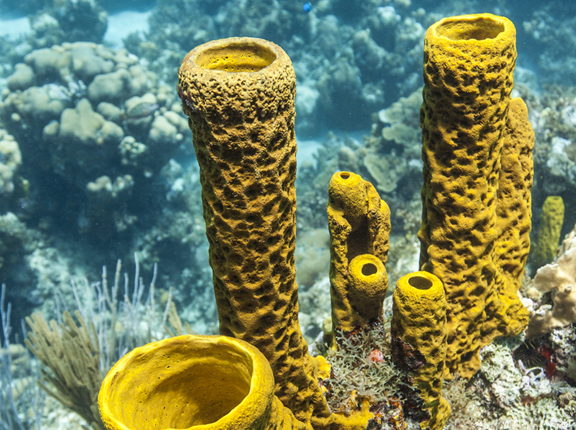Above photo: Tim Calver
By Kimberly John
CJ Contributor
1. The Caribbean Sea is our ‘bread-and-butter’ and the main source of food and livelihoods for most of the region’s 41 million people. But, we also need protection from the sea’s relentless power, a service provided free of charge by coral reefs and mangrove forests. This is why it’s critical that we collectively protect our coastal areas.
2. The Caribbean’s colorful parrotfish are often eaten in our seafood-loving countries, but they are far more valuable alive in the sea. Have you ever wondered where our beautiful, white sand beaches come from? Parrotfish poop contains chewed up fragments of coral that accumulate over time to produce most of our white sand beaches–one adult parrotfish can generate 90kg of sand per year! They also help keep our reefs healthy by feeding on algae, which can otherwise smother corals.
3. The queen conch can spend up to 40 years grazing in our seagrass beds. Its shell thickens as it grows, gradually becoming large and heavy with a gorgeous translucent pink blush around its aperture. The queen conch’s muscular flesh is consumed throughout the islands and its beautiful shell is blown like a trumpet in the exuberant soundtrack of cricket matches.
4. Despite what Bob Marley says, we have far more than three little birds! The Caribbean is a birding hotspot with 560 bird species recorded throughout the region’s islands.
5. Iguanas have been soaking up the sun across our islands for over 12 million years. These remarkable creatures are among the region’s largest land vertebrates and help nature by acting as local gardeners, spreading the seeds of many plant species.
7. Our dramatic silk cotton trees with beautiful buttress roots can grow as tall as a 10-storey building. They have had spiritual significance since the Ciboneys, Tainos and Kalinagos arrived here around 600 CE in silk cotton dugout canoes. Today, they are among the largest and oldest trees in the Caribbean and important sources of nectar and folk medicines.
8. Coral reefs are found throughout the Caribbean, but did you know that most corals only mate once per year? And they won’t mate on just any occasion – scientists believe that the timing is linked to the lunar cycle, usually around the full moon. Check your calendar to schedule a visit to the next coral mass-spawning event!
9. Our islands are surrounded by water, but in the Caribbean, freshwater can be scarce. This water is fundamental to our survival. Small surprise then, that our three indigenous religions, Santeriá, Orisha/Shango Baptists and Voudou, venerate the deities who govern freshwaters.
Kimberly John is the Science Program Manager for The Nature Conservancy’s Caribbean Program. She is a native of Trinidad and Tobago and currently lives in Kingston, Jamaica.
